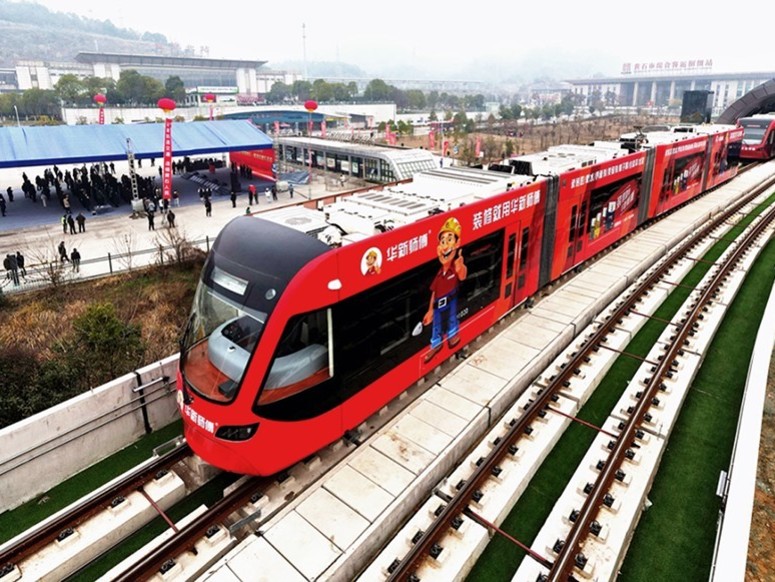Metro and tram openings in 11 Chinese cities in December
Posted on 5th January 2023 at 16:31
In just six days, new metro lines open to passengers in Qingdao, Hefei, Taizhou, Jinhua, Shenzhen, Nanjing, Foshan, Xi’an, Wuhan and Beijing – as well as an all-new tramway in Huangshi.
Chinese cities opened around 305km (190 miles) of new metro lines in just six days in late December, as well as all-new tramway in the city of Huangshi.
A decrease in end-of-year openings compared to recent years is ascribed to adverse effects resulting of the COVID-19 pandemic on construction activity.
Monday 26 December: Qingdao and Hefei
This latest wave of openings began on 26 December. Qingdao (Shandong province) launched its new 30.7km (19-mile) line 4 from Hall of the People to Dahedong, including 25 stops, while on the same day Hefei (Anhui) extended line 5 by 15.5km (9.6 miles) from Wanghucheng West to Jiqiao Road.
Wednesday 28 December: Huangshi, Taizhou, Jinhua, Shenzhen, Nanjing and Foshan
The busiest day for openings came on 28 December, including the introduction of two all-new systems. Huangshi (Hubei province, population 2.5m) inaugurated service on its new 26.9km (16.7-mile) 29-stop tramway; the north-south line runs between Huangshi Avenue and Garden Expo.
Built in just over two years and costing CNY4.58bn (EUR640m), the double-track Yellowstone Rail Transit route runs on a viaduct to serve Huangshi North railway station as well as featuring a 1.5km (0.9-mile) tunnel under a mountain ridge. Rolling stock comprises 36.6m 100% low-floor trams built by CRCC. Each four-section vehicle has capacity for up to 300 passengers and is equipped with onboard batteries (top-ups taking place at stops). Free rides took place 28 December – 31 January.
On the same day, Taizhou (290km/180 miles south of Shanghai) opened its 52.4km (32.5-mile) metro line S1 from Taizhou station in the north to Chengnan in the south of city; construction started in November 2016. Worked using 25kV ac overhead, the 15-stop line uses 140km/h (87mph) Type D rolling stock built by CRRC Tangshan.
Preliminary design for the city’s 62km (38.5-mile) S2 line was approved in December; construction on this CNY26.18bn (EUR3.6bn) project is to begin this year.
In the city of Jinhua (Zhejiang), a 48.8km (30.3-mile) extension was opened between Lingyun and Sports Centre, sharing tracks with the city's existing metro line from Qintang to Sports Centre. Construction of the line’s first section began in July 2017, opened to passengers on 30 August 2022.
Meanwhile, Shenzhen (Guangdong) inaugurated its new line 16 from Universiade to Tianxin (29.2km/18.1 miles), while a peoplemover shuttle opened between Pingshan High Speed Rail Station and BYD North (8km/five miles). This follows an opening of the 40.5km (25.2-mile) line 12 and a 6km (four-mile) line 6 extension in Shenzhen in late November.
In Nanjing (Jiangsu), line 1 was extended from Maigaoqiao to Baguazhoudaqiaonan (6.5km/four miles), while the 13.84km (8.6-mile) line 7 has opened between Mufuxilu and Xianxinlu. This includes ten new underground stations.
Around 1400km (870 miles) to the south-west, the city of Foshan (Guangdong) launched its new metro line 3 from Zhen’an to Shunde College (40.7km/25.2 miles). A second section, taking the line to 69.5km (43.2 miles), is planned to open later this year and represents a total investment of CNY42.57bn (EUR5.8bn).
Thursday 29 December: Xi’an
There was just one inauguration on 29 December, in the city of Xi’an (Shaanxi), when line 6 was extended by 19.5km (12.1 miles) from Northwestern Polytechnical University to Fangzhicheng.
Friday 30 December: Wuhan
On 30 December it was the turn of Wuhan (Hubei), which opened 21.1km (13.1 miles) of line 7 from Garden Expo North to Hengdian, while line 16 was extended by 4.2km (2.6 miles) to Zhoujiahe to Hannan General Airport.
Saturday 31 December: Beijing
Finally, the last day of 2022 brought an extension of line 16 in China’s capital Beijing, from Yuyuantan Park East Gate to Yushuzhuang (14.3km/8.9 miles). Adding nine new stations, the opening takes line 2 to a total length of 46.2km (28.7 miles). Beijing’s metro network now comprises 776 route-km (482 route-miles) and 360 stations across 22 lines. The city also has two street-running tramways: the Xijiao line, opened in December 2017, and the Yizhuang T1 line which opened in December 2020.
Tagged as: China, New LRT line openings, 2023
Share this post:

